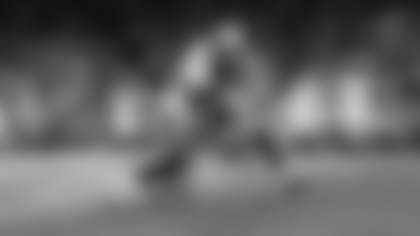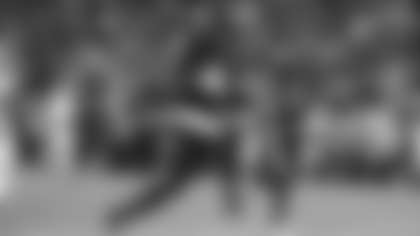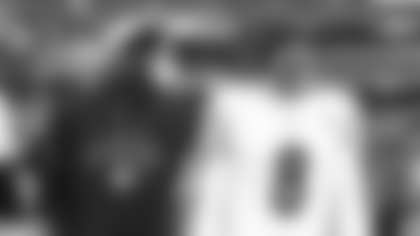Ready or not, here it comes:
- Goodbye, convoluted catch rule. Hello, difficult-to-enforce "use of the helmet" rule.
- The NFL Owners Meetings recently concluded, and the two tent-pole pieces of legislation to come out of the week spent in Orlando were the revised catch rule, and the passing of a new rule designed to stop players from lowering their heads to use their helmets as a weapon in delivering a hit.
- This is how the rule was explained in Wednesday's edition of The Washington Post: "The NFL announced Tuesday it had ratified the rule, which is to result in a 15-yard penalty and a possible ejection whenever a player lowers his head to initiate contact with an opponent. League officials were quick to say it's not a targeting rule, given that it is not focused on whether a hit targets an opponent's head. Rather, they said, it is broader, focusing on the technique used by the player delivering the hit to remove a potentially dangerous approach for both the player delivering the hit and the player receiving it."
- Let's get this out of the way before we go any further: This piece is not written to criticize continued attempts to make football safer. I don't contend the powers that be are trying to make the sport a professional version of "flag football." Nor, to quote Troy Polamalu, do I believe the NFL is becoming "a pansy league." My issues/questions are strictly related to the difficulties of enforcement.
- More from the same edition of The Washington Post: "NFL leaders put the final piece of their just-announced new safety rule in place by saying Wednesday they expect instant replay to be used to help determine whether a player should be ejected from a game for lowering his head to use his helmet to deliver a hit. Even while the final version of the rule continues to be formulated, those within the sport began trying to figure out just how much effect the new restriction on hitting technique will have on NFL playing fields beginning this fall."
- So, here we are. Back again with instant replay being used to officiate games, and being used to adjudicate a tactic that will carry significant penalties to the offender and his team. A 15-yard penalty, and a possible ejection.
- Let's go back to Super Bowl XLIX. Seattle is trailing, 28-24. Ball on the 1-yard line. Let's also pretend that the Seahawks offensive coordinator didn't choose that very situation to have a brain cramp and instead he called the play that should have been called. Or as my football-challenged wife said at the time, "Why didn't they just give the ball to that guy called Beast Mode?"
- The Seahawks offensive line fires off the ball. The Patriots defensive line tries to burrow into the turf because it's a proven football fact that in such situations the lowest man wins. Beast Mode takes the handoff, and with a Super Bowl championship on the line hits it up in there like a man on a mission, which is exactly what he is in that situation.
- Think about all of the players involved at the point of attack on that play, both offense and defense – offensive linemen firing off the ball, staying low, and driving their bodies into the defense; the defensive linemen doing the same, only trying to get lower; linebackers filling, defensive backs attacking the line of scrimmage, and the running back willing to do whatever is necessary to get the pig across the line.
- "The rule potentially applies not only to a defender hitting an offensive player," explained the story in The Washington Post, "but also to a ball carrier initiating contact with a defender and also to a blocker. But much depends on how the rule is enforced."
- In that situation – the final seconds of the Seattle-New England Super Bowl – with that running play called instead of the pass that ended up intercepted, how is there not going to be a violation of this new rule? How could any of the players at the point of attack – again, either on offense or defense – avoid what very well could be called a penalty?
- Again, the intent is honorable, and the guardians of football continue to be active in attempts to make the sport safer, and overall they deserve to be applauded for their efforts because the sport has changed.
- Mike Tomlin is a member of the Competition Committee that brought this "use of the helmet" rule to ownership, and he believes the NFL in some ways is its own worst enemy in the ongoing public relations battle over the future of the sport.
- "Us, the National Football League as an entity – as a collective – we don't sing the song enough, in my opinion, of the quality things we've done to improve the health and safety of our players," said Tomlin. "I'm not in marketing. I coach football, and so I don't think a lot about it. But it just seems like we have a bunker mentality on the subject, and I don't believe that we should. I don't think that we need to. I think that we've been aggressive in improving in those areas, so I think that we should state it as such."
- With two teenaged sons who play high school football, Tomlin is a man who believes in the values the sport can instill in the young people who play it. He also is someone who believes in the advances the NFL has initiated in the effort to make the game safer.
- "I just think that we should highlight some of the things that we've done more than we have to this point because we have taken strong measures to improve the safety of the game for the players, and not only at our level, but at all levels," said Tomlin. "I think the defenseless player is a significant one, but just the incremental steps that we've taken to take the head out of the game in all areas I think has been significant."
- And the move the NFL made during the Owners Meetings this past week could turn out to be the most significant step yet.
- According to Steelers President Art Rooney II, the intent is to eliminate the practice of a player lowering his head and using his helmet as a weapon. He also admitted that questions remain among ownership as to how the rule is to be enforced.
- "We do have questions about what the standard will be for an ejection, how close they are going to call that, how they are going to be advised to interpret the rule," said Rooney. "There are going to be some follow-up meetings between now and the May meeting with coaches and players, to get everybody's input, and with the officiating group, just so that everybody gets a clear understanding on how that part of it is going to be handled."
- Mike Pereira, a former head of NFL officials who now makes a living talking about NFL officials and the job they do, already is on record as saying he doesn't believe it's even possible to enforce this rule.
- "You'll see the same things happen with this as we've seen with the crown-of-the-helmet rule: very few calls," said Pereira during an appearance on SiriusXM Blitz. "I think most of it will be taken care of after the fact with potential fines. "The part that I heard (Thursday), which really does concern me, is the talk of instant replay being involved with this and to validate if there are ejections — if they're not ejected or should be ejected or maybe even the reverse. (It's) much closer to the targeting rule than I thought it would be."
- It's predictable that most of the voices being heard so soon after this new rule was passed would be ones speaking in opposition, but those opinions really don't matter, because the NFL is committed to this cause. And just maybe the league approached this in the same way it approached the new catch rule, in that it started with the desired end and then worked backward from there.
- "If we're able to have replay to confirm when there's one of these fouls that we think should be removed from the game that also confirms whether someone should be ejected, I think there's a great deal more confidence amongst the coaches that it'll be done consistently and fair," Commissioner Roger Goodell said. "And I think it also gives the officials more confidence to be able to make those judgments because they know that there will some type of video input in that. … I actually think that the coaches and the clubs and our officials all collectively feel that is an appropriate thing to do. … We think that's warranted for safety-related issues."
- There's no questioning the intent, because it's a noble one, it's the right one. But are these NFL officials capable of enforcing the rule in the way it was intended when teams unanimously voted to implement it?
- Or will it turn out to become a sideshow, like the old catch rule?














